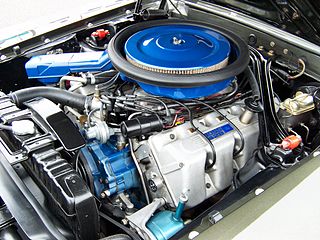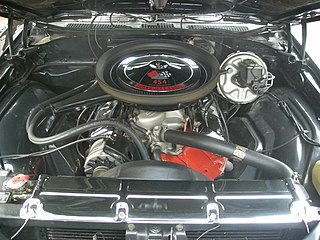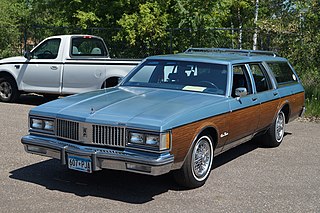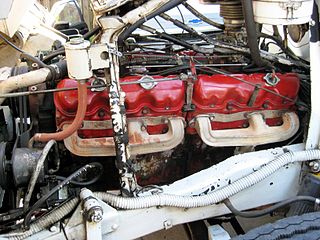
An outboard motor is a propulsion system for boats, consisting of a self-contained unit that includes engine, gearbox and propeller or jet drive, designed to be affixed to the outside of the transom. They are the most common motorised method of propelling small watercraft. As well as providing propulsion, outboards provide steering control, as they are designed to pivot over their mountings and thus control the direction of thrust. The skeg also acts as a rudder when the engine is not running. Unlike inboard motors, outboard motors can be easily removed for storage or repairs.
Yamaha Motor Co., Ltd. is a Japanese mobility manufacturer that produces motorcycles, motorboats, outboard motors, and other motorized products. The company was established in the year 1955 upon separation from Nippon Gakki Co., Ltd. and is headquartered in Iwata, Shizuoka, Japan. The company conducts development, production and marketing operations through 109 consolidated subsidiaries as of 2012.

The Ford Country Squire is a series of full-size station wagons that were assembled by American automaker Ford. Positioned as the top-level station wagon of the Ford division, the Country Squire was distinguished by woodgrain bodyside trim. From 1950 through the 1991 model years, eight generations of the Country Squire were produced. Following the discontinuation of Edsel Bermuda, Mercury marketed the Mercury Colony Park as a divisional counterpart of the Country Squire, sharing bodywork and trim while the Mercury was not available with a six cylinder engine and was more expensive due to the optional equipment on the Ford that was standard on the Mercury.

The Ford FE engine is a V8 engine produced by the Ford Motor Company and used in vehicles sold in the North American market between 1958 and 1976. The FE, derived from 'Ford-Edsel', was introduced to replace the short-lived Ford Y-block engine, which American cars and trucks were outgrowing. It was designed with room to be significantly expanded, and manufactured both as a top-oiler and side-oiler, and in displacements between 332 cu in (5.4 L) and 428 cu in (7.0 L).

The Ford 385 engine family is a series of big-block V8 engines designed and manufactured by Ford Motor Company. The family derives its name from the 3.85-inch (98 mm) crankshaft stroke of the 460 cubic-inch V8 introduced in 1968. A 429 cu in (7.0 L) version was also introduced the same year, with a 370 cu in (6.1 L) variant appearing in 1977.

BRP Inc. is a Canadian manufacturer of snowmobiles, all-terrain vehicles, side by sides, motorcycles, and personal watercraft. It was founded in 2003, when the Recreational Products Division of Bombardier Inc. was spun off and sold to a group of investors consisting of Bain Capital, the Bombardier-Beaudoin family and the Caisse de dépôt et placement du Québec. Bombardier Inc., was founded in 1942 as L'Auto-Neige Bombardier Limitée by Joseph-Armand Bombardier at Valcourt in the Eastern Townships, Quebec.

The Ford small-block is a series of 90° overhead valve small-block V8 automobile engines manufactured by the Ford Motor Company from July 1961 to December 2000.

The Chevrolet "big block" engine is a term for a series of large-displacement, naturally-aspirated, 90°, overhead valve, gasoline-powered, V8 engines; that were developed and produced by the Chevrolet Division of General Motors, from the 1950s until present.

The Chevrolet small-block engine is a series of gasoline-powered V8 automobile engines, produced by the Chevrolet division of General Motors between 1954 and 2003, using the same basic engine block. Referred to as a "small-block" for its size relative to the physically much larger Chevrolet big-block engines, the small-block family spanned from 262 cu in (4.3 L) to 400 cu in (6.6 L) in displacement. Engineer Ed Cole is credited with leading the design for this engine. The engine block and cylinder heads were cast at Saginaw Metal Casting Operations in Saginaw, Michigan.

The Oldsmobile Custom Cruiser is an automobile that was manufactured and marketed by Oldsmobile from 1971 until 1992. Marking the return of Oldsmobile to the full-size station wagon segment, the Custom Cruiser was initially slotted above the intermediate Oldsmobile Vista Cruiser, ultimately above the later mid-size Oldsmobile Cutlass Cruiser.

The GMC V6 is a family of 60-degree V6 engines produced by the GMC division of General Motors from 1959 through 1974. It was developed into both gasoline and diesel versions, and produced in V8 and V12 derivatives. Examples of this engine family were found in pickup trucks, Suburbans, heavier trucks, and motor coaches.

The Mercury Colony Park is an American luxury full-size station wagon that was marketed by the Mercury division of Ford Motor Company between 1957 and 1991. Distinguished by its simulated wood-grain paneling, the Colony Park was marketed as either the premium-trim or the sole full-size station wagon offering of the division. Following the 1960 demise of Edsel, full-size Mercury vehicles shared bodywork with Ford; the Colony Park served as the counterpart of the Ford Country Squire through 1991.

A sterndrive or inboard/outboard drive (I/O) is a form of marine propulsion which combines inboard power with outboard drive. The engine sits just forward of the transom while the drive unit lies outside the hull.
Tohatsu Corporation, previously Tokyo Hatsudoki Company, is a Japanese company manufacturing and selling outboard motors, pleasure boats, portable fire pumps, small fire trucks, pumps for construction and drainage, and refrigeration units for transportation. It also does real estate property management in Japan.

Elmer Carl Kiekhaefer was the owner of Kiekhaefer Mercury and Kiekhaefer Aeromarine and also a two-time NASCAR championship car owner.

The Mercury Monterey is a series of full-size cars that were manufactured and marketed by the Mercury division of Ford from 1950 to 1974. Deriving its name from Monterey Bay, the initial Mercury Monterey served as the top-of-the-line two-door sedan model for 1950 and 1951 to compete with the hardtop models of Oldsmobile and Buick. It came with a vinyl roof covering, upgraded upholstery, and other features. The hardtop was introduced for 1952. During its production, the Monterey would be offered in multiple body styles, ranging from coupes, convertibles, sedans, hardtops, and station wagons.
The Holden straight-six motor is a series of straight-six engine that were produced by General Motors Holden at their Port Melbourne plant between 1948 and 1986. The initial Grey motor was so dubbed because of the colour of the cylinder block, later motors came in the form of a Red, Blue, Black, and the four-cylinder Starfire engine. These engines were fitted to all Australian designed Holdens of the same years, and the four-cylinder Starfire notably also found its way into the Toyota Corona (XT130). The Grey motor is a different engine from the others, while the Red, Blue, Black, and even the Starfire are all inter-related with many common parts and castings.
The Detroit Diesel Series 110, with 110 cubic inches (1.8 L) displacement per cylinder, was introduced in 1945 as more-powerful alternative to the existing Series 71 engines. It was used in a variety of applications, including construction equipment, marine propulsion and power generation. The most popular use was in the Budd RDC self-powered rail car. It was also heavily used in Euclid construction machinery. In 1951 a marine version was also introduced.

Mercury Super 10 Hurricane is an outboard motor built by Kiekhaefer Mercury during the years of 1950 through 1952.
The EMD 1010 or EMD 265 is a line of four-stroke diesel engines manufactured by Electro-Motive Diesel. The precursor to the 1010 was introduced around 1998 as the 265H or H-Engine. The H-engine was initially designed for use as a 6,300 hp (4,700 kW) 16 cylinder, the EMD SD90MAC; however, the early engines were found to be unreliable, and unsuccessful in the market, with the proven EMD 710 2-stroke design being preferred. The EMD four-stroke engine was resurrected in 2015 to meet EPA Tier 4 emissions regulations.





















